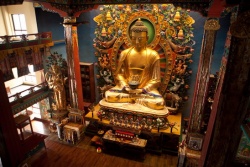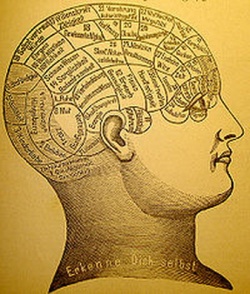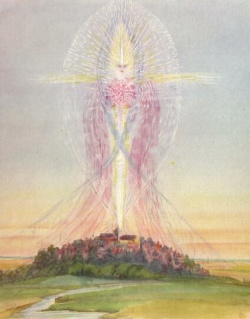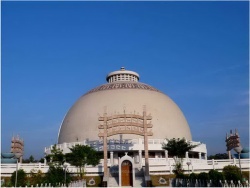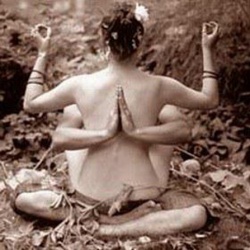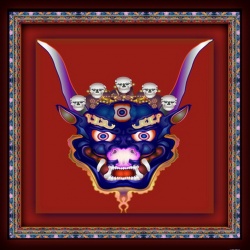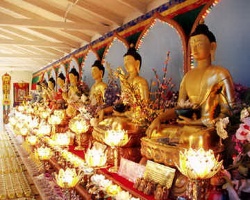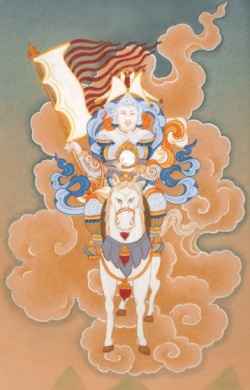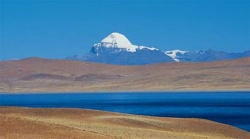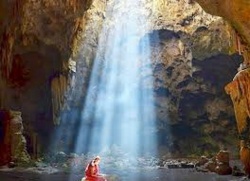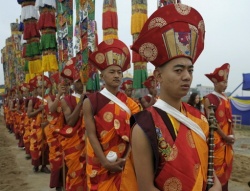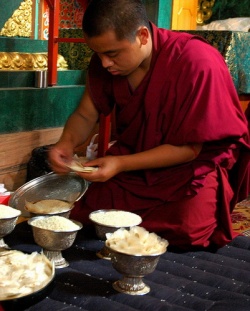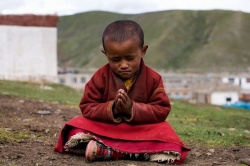Tibetan Buddhism.
チベット仏教 ( Jpn Chibetto-bukkyo)
A distinctive form of Buddhism that developed in Tibet around the seventh century and later in Mongolia and other regions. It is a tradition that derives from Indian Mahayana Buddhism, especially the doctrine of non-substantiality (Skt shunyata ) of the Madhyamika school, and incorporates the doctrine of the Yogachara (Consciousness-Only) school as well as the esoteric rituals of Vajrayana (Tantric, or Esoteric Buddhism). Tibetan Buddhism is also monastic, having adopted the vinaya, or monastic rules, of early Buddhism. It has traditionally involved a large number of monks and nuns. Tibetan Buddhism is sometimes (incorrectly) referred to as Lamaism, due to its system of "reincarnating" lamas. The title lama means a venerable teacher. Some lamas of certain Tibetan monasteries are believed to be successively reincarnated, each head lama being considered a reincarnation of the last in the lineage. In these traditions, sets of instructions are handed down that lead to the identification of a child believed to be the reincarnation of a previous lama. When signs point to a certain child (always a boy), he is tested, and upon passing the tests, is recognized as the reincarnated lama. He then receives monastic training and education and takes on full responsibilities as a lama at a specified age.
Buddhism evolved in Tibet in the early seventh century during the reign of King Songtsen Gampo (581-649). A series of religious kings contributed to its adoption and eventual institution as a state religion. Song-tsen Gampo took as his wives a Nepalese princess and a Chinese princess, both of whom were devout Buddhists. They influenced the king to take faith in Buddhism and build the first Buddhist temples in Tibet. Song-tsen Gampo also sent Thonmi Sambhota to study Buddhism in India. When he returned, he developed a Tibetan writing system based upon the Indian scripts he had studied (Tibet until that time had no set writing system). With this Tibetan script, translation of Sanskrit Buddhist texts into Tibetan began.
Later King Thisong Detsen (742-797) further established Buddhism in Tibet against strong opposition from practitioners of the native religion called Bon. He invited Shantarakshita, a noted Indian monk of the Madhyamika school, to come to Tibet to teach Buddhism. On Shantarakshita's advice, the king also invited the Indian Tantric master Padmasambhava. Padmasambhava is credited with "converting" the Bon deities to Buddhism (incorporating them into the Buddhist teachings) and quelling Bon opposition. Shantarakshita and Padmasambhava together established Tibet's first monastery at Samye in 779. The Nyingma, one of today's four major Tibetan Buddhist schools, claims to preserve the teachings of Padmasambhava. King Thisong Detsen also sponsored a religious debate between Kamalashila, an Indian monk, and Mo-ho-yen, a Chinese priest of the Zen (Ch'an) school, held at the Samye monastery in 794. The king decided in favor of the Indian teacher and thus officially adopted the teachings of Indian Buddhism, or more specifically, the Mahayana teachings founded on Nagarjuna's philosophy of the Madhyamika school and the bodhisattva ideal. He rejected the introspective doctrines of Zen that claimed to ensure sudden enlightenment through meditation. King Thitsug Detsen (806-841), a grandson of King Thisong Detsen, built temples and monasteries and contributed greatly to the translation of Sanskrit Buddhist scriptures into Tibetan as well as to Buddhist art and culture. According to one account, in 841 Bon followers had him assassinated, and his brother, Langdarma, succeeded him. The new king opposed Buddhism. He destroyed temples and monasteries, oppressed Buddhist monks, and abolished Buddhism as an institution; it was not restored until two centuries later. According to another account, the death of King Langdarma led to a power struggle that resulted in the division of the nation and a collapse of the Buddhist Order. In either case, after a period of political and religious turmoil, the ruler of western Tibet invited Atisha, an Indian Buddhist teacher of the Madhyamika school, to the region in 1042 to help restore Buddhism.
Atisha propagated Buddhist teachings, reformed Tantric practices that had involved overt sexual activity, and brought about a revival of Buddhism. Atisha's teachings were inherited by his disciple Domton, who founded the Kadam school of Tibetan Buddhism. (Later this school was absorbed by the Gelug school, also known as the Yellow Hat school, which was founded in the late fourteenth century by Tsongkapa, a Buddhist reformer.) In the same century, Marpa returned to Tibet from his journey to India to study Buddhism and, with his disciple Milarepa, founded the Kagyu school. By the fourteenth century, Buddhism was well established in Tibet, and most of the available Indian scriptures had been translated into Tibetan. A number of lost Sanskrit scriptures have been preserved until today through their Tibetan translations.
Tibetan Buddhism also spread outside of Tibet, most notably in Mongolia and the Mongol Empire. In the mid-thirteenth century, Sakya Pandita, an eminent scholar of the Sakya school of Tibetan Buddhism, journeyed to Mongolia with his nephew and student, Phagpa. Deeply impressed by them, Mongol officials converted to Buddhism. Later Phagpa was appointed imperial teacher and became an adviser to Kublai Khan, the ruler of the Mongol Empire. He was also appointed the temporal ruler of Tibet. In 1578 the Mongolian ruler Altan Khan hosted the renowned Sonam Gyatso, the leader of the Gelug school of Tibetan Buddhism, and conferred upon him the honorific title "Dalai Lama." Dalai is a Mongolian word for ocean. The title was also applied to his two predecessors.
With the aid of the Mongols, the Gelug school and its lineage of Dalai Lamas became the most prominent and powerful in Tibet. The Dalai Lama came to be regarded as the country's spiritual leader and temporal ruler, and each was believed to be a successive incarnation of the bodhisattva Avalokiteshvara, Perceiver of the World's Sounds. Since the popular uprising against Chinese rule in Tibet in 1959 and the resulting exile of the fourteenth Dalai Lama, Tenzin Gyatso (b. 1935), and his followers, interest in Tibetan Buddhism has grown in the West. The Nyingma, Kagyu, Sakya, and Gelug are the four major schools of Tibetan Buddhism, the Gelug being the most prominent.
Tibetan Buddhism Sects and Characteristics
Numerous Tibetan Buddhism Sects emerged after the mid-11th century, including the Nyingma, Gatang, Sagya, Gagyu, Zhigyed, Gyoyul, Gyonang, Kodrag and Xalhu sects. The latter five were rather weak owing to the lack of political support. They were thus forced to join force or were otherwise annexed by other sects, and as individual entities fell into the oblivion of the long flow of history. The following five sects enjoyed impressive popularity:
Nyingma Sect. This sect of Tibetan Buddhism, founded in the 11th century, is also known as the Red Sect and is the oldest sect of Tibetan Buddhism. The sect paid great attention to absorbing the fine points of the Bon religion and, at the same time, did its best to locate Buddhist sutras secreted away when Dharma moved to suppress Buddhism. Based on its practice of Buddhism deeply rooted in the Tubo Kingdom of the 8th century, the sect called itself Nyingma, a word meaning ancient and old in the Tibetan language. Monks of the Nyingma Sect wore red hats, hence the name the Red Sect. The Red Sect mainly advocates the study of Tantrism. Its theory was strongly influenced by Han Chine language Buddhism, and is quite similar with the theory of Chan School of Buddhism in Chinas hinterland. Today, the Red Sect is not only active in Tibetan inhabited areas in China, but also in India, Bhutan, Nepal, Belgium, Greece and France, as well as in the Unite States.
Gatang Sect. The Gatang Sect of Tibetan Buddhism, founded in 1056, primarily advocated the study of exoteric teachings, with later emphasis on Tantrism. In the Tibetan language, Ga refers to the teachings of Buddha, with tang meaning instruction. The combination Gatang thus refers to advising people to accept Buddhism based on the teachings of Buddha. Its doctrines were promoted far and wide and thus exerted great influence on various Tibetan Buddhism sects. However, along with the rise of the Gelug Sect in the 15th century, the Gatang Sect dissolved with its monks and monasteries merging with the former.
Sagya Sect. Sagya means "white land in the Tibetan language. The Sagya Sect of Tibetan Buddhism, founded in 1703, derived its name from the fact that the Sagya Monastery, the sects most important monastery, is grayish white in color. Enclosures in the sects monasteries are painted with red, white and black stripes, which respectively symbolize the Wisdom Buddha, the Goddess of Mercy and the Diamond Hand Buddha. Hence, the sect is also known as the Stripe Sect. The ever increasing influence of the sect and the expansion of feudal forces throughout its formation led to the increasing fame of the "five Sagya Sect Forefathers. The Fourth Forefather Sapan Gonggar Gyaincain was summoned to Liangzhou in 1247 by the Yuan Dynasty (1271-1368) ruler to dial up matters concerning Tibet pledging allegiance to the Yuan Dynasty. This was followed by Sapan bringing various feudal forces in Tibet under control of the Mongols. Following the death of Sapan, Pagan, the Fifth Forefather of the Sagya Sect, emerged as a high-ranking official in the Yuan court. Pagba Was granted honorary titles such as "State Tutor", Imperial Tutor and Great Treasure Prince of Dharma. Thereafter, the Sagya Sect emerged as the Yuan Dynasty representative in Tibet. During the Ming Dynasty (1368-1644), Gonggar Zhaxi, an eminent monk with the Sagya Sect, journeyed to Nanjing, capital of the Ming Dynasty, to pay homage to Emperor Yongle. Gongar was granted an honorary title as the "Mahayana Prince of Dharma, one of the three Princes of Dharma.
Gagyu Sect. The Gagyu Sect of Tibetan Buddhism, founded in the 11th century, stresses the study of Tantrism and advocates that Tantrist tenets be passed down orally from one generation to another. Hence the name Gagyu, which in the Tibetan language means "passing down orally. Marba and Milha Riba, the founders of the Gagyu Sect, wore white monk robes when practicing Tibetan Buddhism, leading to the name White Sect. In the early years, the White Sect was divided into the Xangba Gagyu which declined in the 14th and to 15th centuries, and the Tabo Gagyu. The Tabo Gagyu was powerful and its branch sects were either in power in their respective localities or otherwise dominant amongst feudal forces.
Gelug Sect. The Gelug Sect of Tibetan Buddhism, founded in 1409, was the most famous Buddhist sect in Tibetan history dating to the 15th century. The sect was founded during the reform of Tibetan Buddhism initiated by Zongkapa. Zongkapa himself was born at a time when the Pagmo Zhuba replaced the Sagya Regime in power. At that time, upper-class monks involved in political and economic power struggle led a decadent life and rapidly lost popularity with society. Faced with this situation, Zongkapa called for efforts to follow Buddhist tenets. He proceeded to undertake lecture tours in many areas and wrote books accusing decadent monks of failing to abide by Buddhist tenets. Zongkapa spared no effort to press ahead with Buddhist reform. For example, in the first month of 1409 according to Tibetan calendar, Zongkapa initiated the Grand Summons Ceremony in Lhasas Jokhang Monastery. The ceremony remains in practice even today. This effort was closely followed by the construction of the famous Gandain Monastery and the founding of the Gelug Sect which was famous for its strict adherence to commandments. The Tibetan language meaning of Gelug is "commandments. Zongkapa and his followers wore yellow hats, and thus the Gelug Sect is also known as the Yellow Sect. Since its founding, the Yellow Sect has built the Zhaibung, Sera, Tashilhungpo, Tar and Labrang monasteries, which join the Gandain Monastery as the six major monasteries of the Gelug Sect. The Yellow Sect is also known for formation of the two largest Living Buddha reincarnation systems - the Dalai and Bainqen systems.
Om Mani Pedme Hum
Om Mani Pedme Hum (or Om Mani Pedme Hung), is the most common mantra in Tibet, recited by Buddhists, painted or carved on rocks, prayer wheels or yak skulls and seen around most usually. Tibetan people, almost all Buddhists, do believe that it is very good to practice the mantra of Chenrezi, the Bodhisattva of Compassion (The protective deity of Tibet), which may, relieve negative karma, accumulate merit, help rescue them from the sea of suffering and achieve Buddha hood. Speaking the mantra loud or silently, spinning prayer wheels with the mantra, and carving mantra into stoned are the usual practices.
Then what the mantra means? There is no definite answer to the question since it is not easy to translate the mantra into other languages. According to the Dalai Lama, the six syllable mantra means one can transform one’s impure body, speech and mind into those of a Buddha by following the path which is inseparable integrality of method and wisdom. The first syllable, Om, symbolize one’s impure body, speech and mind, and also the pure noble body, speech and mind of a Buddha. Buddhism claims that an impure body, speech and mind can be transformed into pure ones of a Buddha, who was once impure and later by removing their negative attributes achieved enlightenment on his path. Mani, the jewel, symbolizes factors of method, compassion and love, the altruistic intention to become enlightened. “Just as a jewel is capable of removing poverty, so the altruistic mind of enlightenment is capable of removing the poverty, or difficulties, of and of solitary peace. Similarly, just as a jewel fulfils the wishes of sentient beings”, the Dalai Lama says. Pedme, means lotus and symbolizes wisdom, growing out of mud but not being stained by mud, lotus indicates the quality of wisdom, which keeps you out of contradiction. The last syllable, Hum, meaning inseparability, symbolizes purity can be achieved by the unity of method and wisdom.
Mandala
Mandala, called Dultson Kyilkhor in Tibetan, means container of essence. The Mandala is a tri-dimensional graphical and geometrical representation of the universe. It represents a combination of the enlightened mind and body of Buddha and is considered to have great power. These unique and exquisite works are usually made of colored sand. However, powdered flowers, herbs and even precious gems are also popularly used materials. Although Mandalas were originally created as religious objects used to aid in meditation and decorate and sanctify monasteries and homes, they have become appreciated as artwork for their elegance and beauty.
Mandalas are usually symmetric with series of concentric circles and squares. The center point is the residence of the resident deity, from whom the Mandala is identified. Lines are drawn from the centre until they intersect and form circles and squares. The finished Mandalas have four gates, which symbolize a culmination of the four virtues: compassion, kindness, sympathy and equanimity. Other Buddhist auspicious symbols can also be included in the design. Form and color application techniques are strictly followed in the process of creating a Mandala to show religious meanings.
Meditation
Meditation is a very important part of the Tibetan Buddhism. It is the way to find complete enlightenment. Complete enlightenment is the goal of everyone who uses meditation.
Meditation is an art of living. Nobody can give it to you. It is something you will have to do all by yourself. Words can hardly tell you how to do it. You have to go through it all by yourself. It could be compared with using tools or driving a bicycle for instance. Everybody can tell you how to do it in words. But as soon as you step on a bike and you have to do it by yourself for the first time, all those words turn out to be no more than a little advice. You still have to learn all about cycling by yourself. Learning how to cycle turns out to take a lot of time and practice.
Learning how to meditate is even more difficult. If you are meditating no one can look into your mind. No one can see if you do it right or wrong. You will have to find out yourself if it is going the good way or not. You will have to criticize yourself thoroughly.
It is advised to meditate under the guidance of a teacher. The only thing your teacher can do is to listen to what you feel and to give you hints, but he knows what is right and what is wrong. He also knows the steps to learn to meditate and he knows the different stages of meditation and how you will feel during those periods. It is hardly possible to learn how to meditate by self education or learn meditation by reading a book.
Reincarnation System of Gyalwas (Living Buddha)
The reincarnation system (tulku) is a distinguishing characteristic of Tibetan Buddhism, which is based on the theory that Buddha’s soul never vanishes and incarnates in succession to lead his followers and to accomplish his mission. In 1193, the religious leader of Karma Kagyu tradition of Tibetan Buddhism, Dusum Chenpa and the first Karmapa, passed away. The late lama told his disciples that he would return as a reincarnation. His disciples soon led a search for his infant reincarnation in accordance with his will. Several years later Karma Pakshi turned out as the first reincarnation in Tibet and trained to be Karma Kagyu leader. Then the reincarnation system was adopted by other sects gradually to keep a consistent religious leadership. Gelugpa tradition of Tibetan Buddhism, the Yellow Hat sect, applied the system also to hand down the titles conferred on the third Dalai Lama and the fourth Panchen Lama to keep their established religious and secular title and power. There were hundreds of Gyalwas (Living Buddhas) whose heirs were selected by applying the system, among whom the Dalai Lama and the Panchen Lama are the most prestigious two. By the end of the Qing Dynasty there were 160 high lamas registered wth the Board for Mongolian and Tibetan Affairs, applying the reincarnation system to locate their next successors.
Religious methods and rituals are used to identify a reincarnation of a late high lama. A search party headed by a high lama begins the search soon. After a religious retreat, lamas, dispatched out in disguise, scour Tibet for special signs, new mothers who had unuseal dreams and children who have special knowledge without being taught and special physical traits, such as big earlaps. Oracles, portents, dreams and the late lama’s prophesy will be referred to in order to help the search. Some lamas will be sent to Lhamo Latso, the Oracle Lake, to look for prophetic visions to help locate the reincarnation. Usually, there will be dozens of candidates sought. They will be tested with the late lama’s possessions and those who have amazing knowledge to identify his predecessor’s belongings win out and are the final candidates. Sinc the search could be easily manipulated and dispute occurs, such as in the case of the sixth Dalai Lama, Emperor Qianlong of the Qing Dynasty decided to use a gold urn lottery as a divination to eliminate false candidates. The names and birth dates of the final candidates were written on ivory lots, wrapped up and sealed in the urn. Religious rituals were held before the lottery. After the lottery seriously held in the Jokhang Temple, a new religious leader would be soon installed if the procedure was verified by the central government.
Tsa-Tsa
Tastsa, with its origin in Sanskrit, is a typical Tibetan Buddhism art form. Actually tsatsas are votive tablets in Tibetan Buddhism, usually clay impressions made with a metal mould containing hollowed, reversed image of a deity, a stupa or other sacred symbols. Tibetan people believe that making tsatsas is a merit accumulating action. As holy objects, tsatsas can be found inside stupas, prayer wheel niches, holy caves and monastery altars or beside holy mountains, holy lakes and other holy sites. Small tsatsas can be put inside a portable amulet shrine (called Gau in Tibetan) and taken as amulets by those traveling. Making tsatsa is a compulsory skill of monks in Tibetan monasteries.
Tsatsas fall into different categories in accordance with ingredients added, including plain clay tsatsa, which has no special ingredient; ash tsatsa, which has ashes of late lamas added; medicine tsatsa, which has Tibetan herbs added; humoral tsatsa, which contains liquid produced in the mummifying procedure of late high lamas; and tsatsa made by high lamas themselves or other celebrities. In addition, however, there are some virtual tsatsas made. Lucky travelers may find in some region that Tibetans are using their tsatsa moulds stamping in wind, water and fire! Tibetan people believe everything can be used to make the holy object, even wind, water and fire.
After tsatsas being molded, they are dried or fired to be hard. Only after ritually empowered can they be used as holy objects!
Holy Mountains
In Tibetan-inhabited areas, people have long believed that deities live at the top of high mountains and there are many legends regarding them. In the eyes of the Tibetans, these mountain gods have their various special roles. Older people worship them and make offerings in the hope of living a long and healthy life, while young men hope they will become more handsome and girls more beautiful; herders pray for the possession of large numbers of cattle and sheep while farmers seek bumper harvests.
Tibetan people think that in the Tibetan-inhabited areas there are four great holy mountains: Yalhashangbo in U-Tsang areas, Nyangqentanglha in the north, Kulharigyi in the south and Wodegonggyi in the east.
Four great mountain gods, as well as another five famous ones, make up the core of the system, which is called "nine gods forming the world". These nine mountain gods are Wodegonggyia, Yalhashangbo, Nyangqentanglha, Nganyimaqen, Choqentunri, Gangbalhari, Sholhachubo, Chowoyugyia, and Siwokari. In addition, because of different geographical conditions, each area has its own particular local mountain gods, such as holy mountains in Gangdese in western Tibet and the Five-Longevity Sisters in the Tingri district.
There are many legends about mountain gods, and what follows is the story of Nganyimaqen.
Long ago, there was an old man named Wodegonggyia. In order to release the people in the Tibetan-inhabited areas from disaster, he sent his eight sons to help them. Seven of them went to north of Tibet and Khamba, and the fourth son was sent to Amdo. On his departure, the old man told the fourth son: "Be kind to people with braids on their head as fathers; be kind to people with decorations on their back as mothers; be kind to young people of your own age as brothers. Only by doing so will you become the strongest person in the world. Only by winning the confidence and help of the Amdo people can you succeed." They then pledged to meet in Amdo in the Year of the Horse.
The young man tramped over 99 mountains, 99 rivers and 99 grasslands before arriving in Amdo, where, due to the presence of devils, in summer there were floods, beasts of prey haunted the mountains and evil men hurt the common people...
The young man annihilated the devils, subdued the beasts of prey, and punished evil men, so people in Amdo were able to begin living peaceful lives. He gained the peoples love and esteem, and was elected as their leader. He was also made a Buddhist guardian by the gods and controlled the mountains and rivers in Amdo.
In the Year of the Horse, on the day when father met the son, 1,500 mounted knights with human bodies and the heads of beasts, carrying broadswords and pikes, received Wodegonggyia at the source of the Yellow River. Everyone in Amdo gathered around the palace to welcome them.
Wodegonggyia and his son met the people outside the palace and all people brought fresh zanba, buttered tea, freshly boiled mutton, and qingke wine as an offering. People sang and danced to their hearts content.
Suddenly there came the sound of thunder and the palace rose into the clouds.
In order to remember their hero, the local people called the nearby snow mountain as "Nganyimaqen" and every Tibetan Year of the Horse, people would come to attend "Sibaqihe Lha Gully" and worship the embodiments of Wodegonggyia and his son.
Nganyimaqen is the name by which it is called by local, who speak of the Nganyimaqen mountain god or Bomuqinmure. It lies on southern bank of Qinghai Lake. It is said that there were 360 brother deities accompanying the mountain god in Nganyimaqen, who are called the 360 "Mar" for short. On the left arm of the Nganyimaqen mountain god there was a bag made of eagles skin; he rode on a white horse (some say a lion).
Yalhashangbo mountain god lived on Yalhashangbo Mountain in Yarlung and was the leader of all the local deities, and was later absorbed as a Buddhist guardian by Padmasambhava. He is always portrayed as a figure in white clothes riding on a white yak and with an avalanche spewing from his mouth, and was regarded as second among the "nine mountain gods forming the world", next only to Wodegonggyia.
According to local legends, the Yalhashangbo mountain god was a white yak with a constant avalanche emerging from its mouth and nose. It could destroy rocks, caused floods and could even make love with common people to give birth. As the highest deity, the mountain gods led all the local protective gods and earth gods in Yarlung. The Yalhashangbo mountain god had a wife and children, his spouse being leader of the female deities who dressed in pink, carried lightening in her right hand and hail in her left, and flew on a lightening bolt.
The Nyangqentanglha mountain god was the leading deity in the Nyangqentanglha Mountains extending hundreds of km through the wilderness of northern Tibet. The Nyangqentanglha mountain god was among the "18 deities in charge of hail". It comes of three incarnated shapes: the first is a person dressed in white with a white kerchief on the head, holding a horsewhip in the right hand and a short sword in the left, riding on a white horse; the second is dressed in armor made of refined jade and a black bear skin, wearing a helmet made of refined jade and carrying a cold shining iron sword; the third one is dressed in crystal armor and has a white crystal pike.
When people passed Tanggulha Mountain, they would burn joss sticks and offer various sacrifices to the mountain gods. In legends, Nyangqentanglha mountain gods were also viewed as protective gods of money and valuables.
Kangrenboqe occupies an important place in the hearts of herders in northern Tibet. In the past, herders of the Amdo Dorma tribe often went to Kangrenboqe Mountain with their families and spent several months or several years on the way or even lived for a long time in Kangrenboqe. Herders often take ritual walks around Kangrenboqe in the Tibetan Year of the Tiger and Zari in the Tibetan Year of the Monkey.
During the 7th and 8th months in the Tibetan calendar, Amdo Dorma herders take ritual walks around a holy mountain. According to custom, only men can perform this ritual... Before starting, they will invite monks to chant sutras, and then they ride on horseback or walk around holy mountains clockwise. During the progression, they will burn aromatic plants, place engraved Mani stones, offer hada to the holy mountains, and scatter or place butter, milk dregs, ox hair ropes, Tibetan knives, or even silver, coral, agate as a sign of worship.
Herders in Amdo Dorma tribe do not hunt on the holy mountains, but plants and minerals can be collected to make Tibetan medicines with great curative effect. But before collection, they must pray and burn aromatic plants. Some herders will kowtow and worship holy mountains every evening.
In Tibet, holy palaces to worship mountain gods can found everywhere. Fluttering sutra streamers and aromatic smoke give you a great feeling that you are protected and blessed by the mountain gods.
In the Tibetan-inhabited areas in Gansu and Qinghai, during the autumn harvest, each family will send a person to the high mountains and deep forests to offer sacrifices and worship the mountain gods. On that day, according to an old herderstradition, people will collect provisions and oil and other food from each family and dine together on wild pastures. They worship and pray that their crops will prosper and livestock multiply; afterwards, the items used in the worship are distributed to each family.
Sacred Animals
Eagles are sacred birds in the mind of Tibetan people. And also the sheep or cows with red color or colored strips on their body are considered as sacred animals. It is forbidden to disturb them or do harm on them.
Full Prostrations
The Tibetan prostration is a ritual in Tibetan Buddhism. Palms put together, Tibetans prostrate themselves on the ground, with the head, arms, and knees down on the ground and move forward slowly, following every step with a prostration.
This is the way to express their most honest hearts to the Buddha, as they walk from their hometown to Lhasa. During the long journey, they wear wooden kneepads to protect their knees and fur to ward off dust on their faces, and prostration every three steps until they arrive in Lhasa.
A prostration rule is strictly practiced by Tibetans.
First, stand straight, put the palms together, lift them above the head, and stride one step. Keeping the palms together and moving forward, the devotees stride the second step. For the third step, they move their palms to the front of their breast, and, as they stride forward, make their arms parallel to the ground with the centers of their palms facing the earth. Finally, they fall on their knees, lie down on the ground, touch it with their forehead, and then stand up and do it again. While doing the prostration, they are supposed to patter the Six Words Sutra without stopping.
Tibetan Prayer Wheels
Prayer wheels, called Chokhor in Tibetan, are very common religious objects in Tibet. A hand held prayer wheel is a hollow wooden or metal cylinder attached to a handle. Om Mani Padme Hung mantras are printed or etched in relief on the cylinder. Attached to the cylinder is a lead weight with a chain, which facilitates the rotation. Tibetans use prayer wheels to spread spiritual blessings to all sentient beings and invoke good karma in their next life. They believe that every rotation of a prayer wheel equals one utterance of the mantra, thus the religious practice will in return help them accumulate merits, replace negative effects with positive ones, and hence bring them good karma. The religious exercise is part of Tibetan life. People turn the wheel day and night while walking or resting, whenever their right hands are free while murmuring the same mantra. Buddhists turn the wheel clockwise. Bon followers turn the wheel counter clockwise.
Prayer wheels vary in size and type. Not all prayer wheels are hand held. It is common for bucket-sized prayer wheels to be lined up on wooden racks along walking paths circling monasteries and other sacred sites, for the benefit of visiting pilgrims. Larger water, fire, and wind prayer wheels are built so that they are empowered by the flowing water, the flaming light, and the blowing wind which drive them, and can later pass their positive karma to all who touch them.
Religious Objects
Prayer Flag: The fluttering prayer flags can often be found on rooftops, at mountain passes and across rivers along with piles of mani stones, and other places they consider sacred. Prayer flags are actually colorful cotton cloth squares, (usually white, blue, yellow, green and red), with images, mantras and prayers printed on with printing woodblocks. Usually at the center of a prayer flag, there is a Wind Horse which bears the Three Jewels of Buddhism. On the four corners of the flag, images of four sacred animals are printed, which are Garuda, Dragon, Tiger and Snow Lion, representing four virtues, wisdom, power, confidence and fearless joy respectively. Sometimes auspicious Buddhist symbols can be found on the edges. In the blank between the images, prayers and mantras are printed. There are two kinds of prayer flags, the horizontal ones called Lungta in Tibetan and the vertical ones called Darchor. The horizontal prayer flags are serial printed cotton clothes and connected at the top edges with a long thread. The vertical ones, less used, are usually single pieces or serial blocks sewn on poles, planted on the ground or on rooftop. Tibetans believe the prayers and mantras will be blown heavenward as offerings to their deities and will also bring benefits to the one who hangs them, his neighborhood and all sentient beings, even flying birds. However, once the flags are hung on wrong astrological dates, they will only bring you negative results. Longer it hangs, greater obstacles arise. Old prayer flags will be removed and replaced with new ones in every Tibetan New Year.
Mani Stone: Travelers to Tibet may find mani stones and mani stone mounds almost everywhere, in monasteries, beside villages, along paths and on mountains. Sometimes they are decorated with sheep and yak horns. Usually the universal mantra Om Mani Padme Hum is inscribed on smooth stone plates, pebbles and rocks. Images of deities and great adepts, and sutra texts are also normal themes. Tibetan people build these bizarre artworks to show their piety to their deities and the Buddhas teachings. When encountering a mani stone mound, Tibetan people will circumambulate it clockwise to get health and peace and ward off negative adversity.
Stupa: Stupa, Chorten in Tibetan, is an important religious monument in Tibet. The unique religious architectural form, expressing significant religious symbolism and presenting Buddhas physical presence, generally consists of three parts, a whitewashed base, a whitewashed cylinder and a crowning steeple or shaft. The square base foundation, representing the Buddhas lotus throne, symbolizes earth, the state of solidity and five forces named concentration, mindfulness, perseverance and wisdom. The four stepped base may or may not have openings. Above the base is a square or hexagon four stepped pedestal which represents his crossed legs. Seated on the base is the cylinder, representing the Buddhas torsos, which symbolizes water, the state of fluidity and seven essential conditions of enlightenment, namely concentration, effort, equanimity, flexibility, mindfulness, joy and wisdom. Sometimes a stupa has a shield like grillwork in one face, from which relics of high lamas, statues and other items are put inside. Between the cylinder and the crowning steeple, there is a square box, called harmika, which is deemed as the Buddhas eyes and considered as the residence of the gods, symbolizing the eightfold noble path. The crowning steeple, the Buddhas crown, is usually hand-made of brass and/or covered with gold leaf. It is segmented into 13 tapering rings, a parasol and a twin symbol of the sun and the moon. Those rings, representing fire and the thirteen steps of enlightenments, successively symbolize ten powers of the Buddha and three close contemplations. The stylized parasol, representing wind, wards off all evils. At the top of the steeple is the twin symbol of the sun and the moon, which represent wisdom and method respectively. A flaming jewel may be found atop the twin symbol, symbolizing the highest enlightenment.Stupas always house items which Buddhists think sacred. Sutra scripts, Buddha statues, Tsa-Tsas, hair clippings, fingernails, relics and cremation ashes of saints are usually enshrined in stupas along with jewels, herbs and other stuffs. Stupas are also used as tombs in which mummified bodies of high lamas are buried.Stupas are also built in case of commemoration and merit accumulation except for the funeral use of high lamas. Building a stupa and any other work done on it are considered of highest purity and merit. Buddhists always show their devotion by circumambulating a stupa clockwise. Circumambulation can also accumulate merit. The size and style of stupa may vary, from the large stupas commonly seen in monasteries and on road passes, to portable ones many Tibetan people carry with them as sacred object and amulet.
